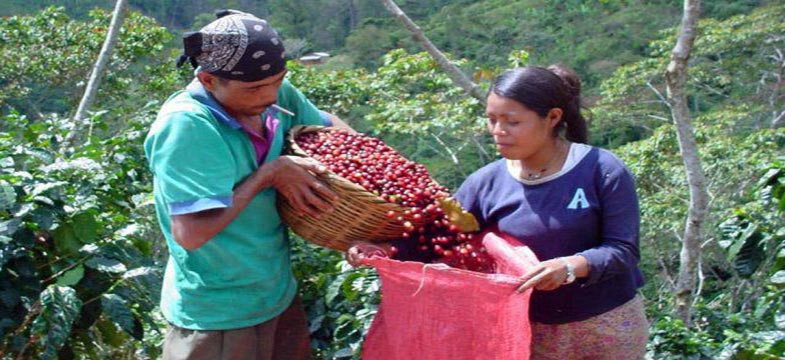In Nicaragua everyone is considered a poet until proven otherwise. This rich land of lakes, volcanoes, poets and rebels is also the latest buzz in what some are calling the quality coffee revolution. Since coffee came to Nicaragua in the mid 1800s, it has played a significant role in Nicaragua’s economy and environment. Coffee has been an engine for Nicaragua’s national economic development process. It is among the nation’s primary sources of foreign exchange and provides the economic backbone for thousands of rural communities. More than 40,000 coffee farm families cultivate this golden bean often in a way that preserves Nicaragua’s precious forests and threatened biodiversity. In the late 1990s, coffee annually contributed US$140 million to the national economy and provided the equivalent of 280,000 permanent agricultural jobs.
NEWS (2015)
December 30, 2015 – Café en segundo lugar de exportaciones nicaragüenses ![]()
December 29, 2015 – Venta de café sigue lenta ![]()
History of Coffee in Nicaragua
Geography and History
Nicaragua has three primary geographic regions: the Pacific plains, central northern mountains and the Atlantic coastal lowlands. Rains are relatively infrequent in Nicaragua’s drier Pacific northwest region and almost continuous in the coastal lowlands. For most of the rest of the country, the rainy season begins in May and ends sometime in December. Coffee cherries are generally harvested from October through February.
Nicaragua’s first coffee cherries were planted on the Pacific’s plain mesa, however most production comes from three regions within Nicaragua’s Central northern mountains.
These regions include the Segovias (Estelí, Madriz and Nueva Segovia) known for their floral aromas, distinctive flavor and bright acidity. The Matagalpa and Jinotega regions are also favourable for coffee cultivation, especially in the Isabelia and Dariense mountain ranges. These areas possess rich volcanic soils, a humid tropical forest climate, and lush vegetation, including a great variety of lichens, moss, ferns, and orchids. The outer regions of Matagalpa County border the BOSAWAS Natural Reserve, the largest land preservation initiative in Central America. Matagalpa is generally mountainous, with altitudes ranging from 600 to 1500 meters

Coffee culture and commerce in Nicaragua
Today coffee also supports the 45,334 families that own and operate small farms. These are important contributions in a country of six million with close to a 50% unemployment rate. Ninety five percent of Nicaragua’s coffee cultivation is considered “shade grown”. Farmers cultivate shade coffee under the canopy of native and exotic trees. These trees and the farmers’ management practices help sustain ecosystem services such as biodiversity, soil, and water conservation. As Nicaragua’s environment suffers high rates of deforestation, soil erosion and water contamination, the 108,000 hectares of coffee land become increasingly important for their production of environmental services.
Different farmers produce coffee in different ways, under different agroecological conditions and in a variety of positions vis-à-vis the commercialization chains that bring the coffee from crop to cup. In general, farm size has a direct relationship with the different forms of coffee production and commercialization. Medium, large and the agro industrial plantations maintain a permanent labor force. Most large-scale and the agro industrial plantations have integrated processing facilities on the farm, occasionally exporting their own coffee. These farms usually provide living quarters and food to farm worker families. Rural landless workers continue to live in extreme poverty.
During the coffee harvest the large plantations employ and house hundreds, sometimes thousands of coffee pickers.
An estimated 95% of Nicaragua’s coffee farmers are micro and small-scale producers. The family is the primary source of labor on these farms. These households often produce corn and beans, and/or work off the farm. In contrast to the micro-producers, the small-scale farmers generally employ day laborers during the coffee harvest. Most Nicaraguan small-scale farmers grow more than half of the food they eat. These farmers intercrop bananas, oranges, mangos, and trees for firewood and construction within their coffee parcels.
TOURISM
Ruta del Café
The coffee crisis and response in northern Nicaragua
Nicaragua’s economy is still largely dependent on agriculture. Coffee accounts for an estimated 30% of the foreign currency generated from agricultural exports. When the coffee prices crashed in 1999-2003, three of the six largest national banks collapsed due to their high levels of coffee debt and other scandals. It is difficult to isolate the impacts of the coffee crisis from the series of negative shocks (Hurricane Mitch, drought, declining commodity prices) that continue to affect Central America. In Nicaragua, the 1999-2001 droughts added further stress to low coffee prices. In the tropical dry regions, including the northern departments of Estelí, Madriz and Nueva Segovia, the farmers did not harvest their subsistence crops. Small-scale farmers lived off mangos, yucca, bananas and the other subsistence crops that they intercrop with their coffee.
People’s vulnerability to the falling prices depends upon their location in the coffee commodity chain and their access to assets such as land, credit, diversified income sources and social networks. The coffee crisis is felt by most of the country’s estimated 45,334 micro and small-scale farmers. These smallholder households sell coffee as their primary source of cash income. As the coffee crisis deepened, these farmers talked about pulling their children out of school, migrating to the cities or Costa Rica and increased heath problems. The micro producers often work as day laborers on large plantations because their small parcels and current management practices are not sufficient to support the family. Researchers estimate that Nicaraguan laborers have lost over 4.5 million days of work during the first two years of the coffee crisis. The rural landless coffee workers are more vulnerable than smallholders.
During the worst parts of the crisis, banks and plantation owners stopped paying, and later stopped feeding their workers. Hungry and without work, hundreds of families marched down from their individual parcels and large plantations to the major highway running to Managua. Families grouped together along roadsides and in public parks where they lived in miserable conditions surviving on food donations. They demanded food, work, health care, and land. After three years of these annual marches the rural workers’ union won small plots of land for more than 3000 landless coffee farm-worker families. This bottom-up land-reform process and historic agreement is known as El Acuerdo de las Tunas, named for the school along the Pan American Highway where the agreement was finally signed.

The Fair Trade cooperatives cultivate alternatives amidst crisis
The cooperative movement in northern Nicaragua has a long history reaching back early 1900s. Augusto César Sandino formed Nicaragua’s first cooperative in Wiwilí in the 1920s, and later the Somoza dictatorships occasionally promoted cooperatives to maintain elite control of the agro-export sector and fend off the risks of communism. However, as of the early 1970s there were only 11 cooperatives with an estimated 460 members in Nicaragua. The Nicaraguan revolution in 1979 and subsequent Sandinista government, which lasted from 1980 to 1990, had a significant influence on many–but not all–of the current cooperatives. During this time, cooperatives were given land that was redistributed to those who were once farm workers.
Equal Exchange pioneered alternative coffee marketing from Nicaragua as part of the US movement against wars in Central America in the 1980s. Progressive church-based constituencies in Europe, linked to liberation theology-inspired cooperatives in southern Mexico drove the initial demand for Fair Trade/Organic coffee in the late 1980s. After the revolutionary party was voted out in 1990, many cooperatives collapsed; others began to unite and form secondary level organizations to secure land titles, and later to provide technical assistance and access to markets for their members. From 1993 to 2001, the total number of agricultural cooperatives decreased by 40%, while cooperative membership actually increased by more than 10%. As these cooperatives began forming more direct connections to European Fair Trade and the US specialty roasters, they realized the need to unite even more to be able to focus on specialized commercialization practices and meet the increasing demands of the changing global coffee economy. These newer export-oriented cooperative unions included specialized agricultural processing infrastructure, strong quality assurance programs, and highly trained professional staff. They have developed this business component of their organizations while simultaneously strengthening their capacity to support education, housing and environmental projects among their members.
In addition to quality improvement, many of the cooperatives are using their Fair Trade premiums to reinvest in their cooperatives and to create social programs for their members. For example, several of the cooperatives have managed to build their own dry processing plants – which are owned by the members. This achievement enables the farmers to better control for quality, to employ their members, and to cut down on production costs. Many of the cooperatives have established educational scholarship programs for the members and their children. Others have used their Fair Trade premiums to create Women’s Savings and Loans Programs, and to support income diversification projects including agro-ecotourism programs and beekeeping.
Nicaragua’s strongest smallholder coffee cooperatives have organized collectively and have linked to certified Fair Trade coffee as an important component of their organizational development strategy. After working together on a successful coffee quality improvement project, these cooperative unions decided to unite to form the La Asociación de Cooperativas de Pequeños Productores de Café de Nicaragua, CAFENICA, (or The Nicaraguan Association of Smallholder Coffee Cooperatives) to represent their political and economic interests. CAFENICA represents more than 80% of the smallholders affiliated with Fair Trade cooperatives.
CAFENICA serves as a platform to lift up smallholder voices and defend their interests. The organization also tries to influence coffee, rural development, and Fair Trade policy at national and international scales.
In Nicaragua, CAFENICA has represented smallholder interests in national coffee fairs, rural development policy debates, and as an active contractor for long term research projects. The Nicaraguan cooperatives have used CAFENICA as an umbrella organization to participate in international industry fairs, including the Specialty Coffee Association of America and Hostelco (Spain). Finally, CAFENICA has proven itself to be an effective collective platform for influencing Fair Trade policy.
CAFENICA and the smallholder Fair Trade cooperatives have actively participated in the Nicaraguan Cup of Excellence Competition. The Cup of Excellence is a competition to identify the best coffees in a country through the use of an international jury and blind coffee tasting (cupping) tests. As late as 2004, many skeptics continued to argue that small-scale farmers and cooperatives were not capable of producing quality coffee. In the end, farmers connected to the Fair Trade smallholder cooperatives won nine of the top 11 prizes, with more than 60% produced by small-scale farmers. Many Fair Trade allies still remember when the awards were announced in the exclusive Social Club in Matagalpa. The hard working hands of the small-scale producers were there to receive the top awards. Merling Preza, General Manager of one of the Fair Trade co-ops, PRODECOOP, also remembers this as one of the best moments in Nicaragua’s cooperative’s history, “the time when we showed them that yes we can.” Later in the press conference, she reminded everyone that producing quality coffee, just like working to improve people’s quality of life, is the Responsibilidad de Todos (Responsibility of Everyone).

